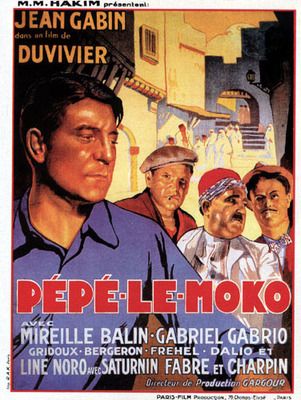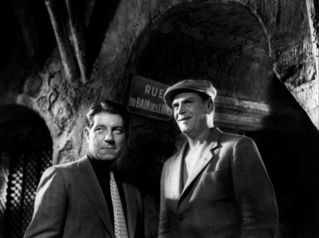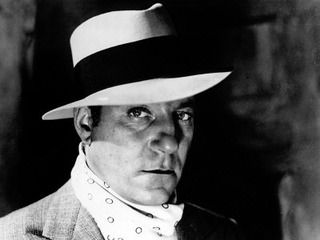
Pépé le Moko
1937
Director: Julien Duvivier
Starring: Jean Gabin (be still my heart), Lucas Gridoux, Mireille Balin, Line Noro
Before American filmmakers started to sink their gritty, grimy teeth into film noir, that most beloved genre of mine, there was Pépé le Moko. So much of the essence of noir is painted across this picture, a full five years before the first official noirs started being made by Hollywood. This, right here, this is a turning point towards everything that noir would become. The nihilism, the doomed and fatally flawed hero, the temptation, the world of crime versus law and order… it’s all there. And, just like nearly every noir I’ve ever seen, the first time I saw this film about five years ago, it was okay. I was not bowled over. When I recently rewatched it, I found it so much more enjoyable, so much more inspiring. Noir grows on you, and Pépé le Moko is no exception.
Pépé (Gabin), our titular character, is the gangster lord of the Casbah in Algiers. The police are desperate to get their hands on him for multiple armed robbery counts, but the Casbah cannot be penetrated. As long as he is there, he is secure. A clever cop (Gridoux), though, knows that if he waits long enough, Pépé will slip up and leave the safety of the Casbah. No sooner are these words spoken when temptation arises in the form of lovely young Gaby (Balin), a Parisian tourist. Pépé longs to leave Algiers and return to Paris with her, but he also knows what waits for him beyond the shelter of the Casbah.
Jean Gabin is a sexy sexy beast. For my money, I’d rank him in my top five sexiest actors of all time, right next to young hot Marlon Brando (as opposed to old fat Marlon Brando). And he simply oozes sex appeal through every pore as Pépé. He is also, easily, the most fascinating character in the film. His strong and violent exterior cloaks an interior of frustration and longing. It is easy to understand how he has charmed the gypsy Ines (Noro) into being his live-in girlfriend, all the while wooing outsider Gaby. I could watch Gabin all day as Pépé and never grow weary of his performance. Pépé is a whirlwind, a force of nature, a modern day Heathcliff. Furious one moment, then singing the next. Happy and besotted, then drunk and desperate. Gabin goes all out, man, all out. He was one of France’s biggest film stars of the 1930s, and this film easily explains why. I’d like to break me off a piece of that… mm-hmmm…

The second star of the film behind Gabin is not a person but a setting: the Casbah. This is a film distinctly tied to its location; it would be immensely challenging trying to transplant it elsewhere, because specific locations drive the action. Pépé is safe in the Casbah but longs to escape to Paris. At the beginning of the film, the Casbah is given royal treatment when it is introduced. Its roads and winding, labyrinthine alleys don’t compare to the true maze of the interlocking rooftops and connected homes. A criminal can go up one set of stairs, race across several roofs, then descend a new set of stairs in a completely different section of the Casbah – and the movie shows this. No wonder the police can’t catch Pépé there. When we first see the Casbah, it is awe-inspiring in its complexity. But as the film progresses, the Casbah changes. It becomes more claustrophobic, more cage-like. Pépé is free if he stays in the Casbah, but that also makes the Casbah his prison. Set one foot on the outside, and clever Inspector Slimane (Gridoux) is waiting. His price of freedom is therefore also his prison sentence, and Duvivier’s direction is perfect in portraying this evolution. What at first appears exotic in the film ultimately becomes tiring and small, with sets seemingly shrinking before our eyes. Images of bars, fences, and cages keep appearing, echoing the sentiment that even in his freedom, Pépé is trapped.

An essay by Michael Atkinson that accompanies the Criterion Collection DVD of this says, among other things, that Pépé le Moko is first and foremost a love story between Gaby and Pépé. I completely disagree. Gaby, as a character, is fairly flat and rather uninteresting. Even Pépé himself notices her jewels before he notices her. This is not to say she’s not vital to the film; she absolutely is, but in a symbolic rather than romantic way. She represents everything that Pépé wants to return to. Paris, the Metro, corner bistros; that is Gaby. That is her world. That is what Pépé is longing for, not another pretty girl. Contrasted with this, we have the relationship between Pépé and Ines, his gypsy girlfriend. Ines is a far more interesting character than Gaby, fiery and viciously protective. Besides being a captivating screen presence herself, Ines clearly represents Pépé’s relationship with the Casbah. He is safe but trapped and longs to escapes. Ines’ actions when Pépé tries to act on these feelings are fascinating, especially when read through the lens of how the Casbah responds.
Do I consider Pépé le Moko film noir? I’m not sure. My first instinct is to say “no,” but there is so much of noir in it. Do I love Pépé le Moko like I love film noir? Hell yes. It’s surprisingly gritty and violent, and terribly dark, all while maintaining a brilliant romanticism. Gabin is amazing and sexy and full of star power. I’ll take him over Bogie any day.
Arbitrary Rating: 9/10
*Seriously, when I first watched this five years ago, I probably would have only given it 6 or 7 out of 10. My tastes have changed. I loved it so much more on a second viewing.


Hmmm... perhaps watching it a second time is the thing to do. I found Pepe unbelivable as a hardboiled criminal and top dog of the kasbah. Too much Don Juan and too little Godfather. I much prefer Gabin in La Grande Illusion where his supporting cast is also top notch. But then I also only saw Pepe le Moko once.
ReplyDeleteI agree on your analysis of Gaby. It is not a love story. She is only a symbol.
Grand Illusion is another film I really need to revisit, so I will pass on any intelligent comparison between these two films here.
DeleteAll I'll add is that I have to superficially admit to preferring sexy Gabin in this movie to prisoner or war Gabin in Illusion.
I really didn't expect to like Pepe le Moko so much more on my second viewing. It really surprised me, how much I enjoyed it!
golden goose
ReplyDeletepalm angels hoodie
off white hoodie outlet
kyrie 7
supreme outlet
fear of god outlet
a bathing ape
yeezy boost 350
jordan outlet
supreme clothing
duuiixaang985k
ReplyDeletegolden goose outlet
golden goose outlet
golden goose outlet
golden goose outlet
golden goose outlet
golden goose outlet
golden goose outlet
golden goose outlet
golden goose outlet
golden goose outlet